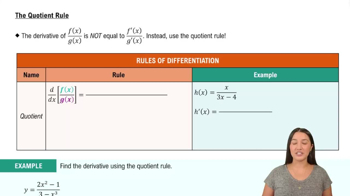Table of contents
- 0. Functions7h 52m
- Introduction to Functions16m
- Piecewise Functions10m
- Properties of Functions9m
- Common Functions1h 8m
- Transformations5m
- Combining Functions27m
- Exponent rules32m
- Exponential Functions28m
- Logarithmic Functions24m
- Properties of Logarithms34m
- Exponential & Logarithmic Equations35m
- Introduction to Trigonometric Functions38m
- Graphs of Trigonometric Functions44m
- Trigonometric Identities47m
- Inverse Trigonometric Functions48m
- 1. Limits and Continuity2h 2m
- 2. Intro to Derivatives1h 33m
- 3. Techniques of Differentiation3h 18m
- 4. Applications of Derivatives2h 38m
- 5. Graphical Applications of Derivatives6h 2m
- 6. Derivatives of Inverse, Exponential, & Logarithmic Functions2h 37m
- 7. Antiderivatives & Indefinite Integrals1h 26m
- 8. Definite Integrals4h 44m
- 9. Graphical Applications of Integrals2h 27m
- 10. Physics Applications of Integrals 2h 22m
3. Techniques of Differentiation
Derivatives of Trig Functions
Problem 3.5.53
Textbook Question
Verifying derivative formulas Verify the following derivative formulas using the Quotient Rule.
d/dx (sec x) = sec x tan x
 Verified step by step guidance
Verified step by step guidance1
Step 1: Recall the definition of secant. The secant function is defined as \( \sec x = \frac{1}{\cos x} \).
Step 2: Apply the Quotient Rule. The Quotient Rule states that if you have a function \( \frac{u}{v} \), its derivative is \( \frac{v \cdot u' - u \cdot v'}{v^2} \). Here, \( u = 1 \) and \( v = \cos x \).
Step 3: Differentiate \( u \) and \( v \). Since \( u = 1 \), \( u' = 0 \). For \( v = \cos x \), \( v' = -\sin x \).
Step 4: Substitute into the Quotient Rule formula. Plug \( u, v, u', \) and \( v' \) into the formula: \( \frac{\cos x \cdot 0 - 1 \cdot (-\sin x)}{(\cos x)^2} \).
Step 5: Simplify the expression. The expression simplifies to \( \frac{\sin x}{\cos^2 x} \), which can be rewritten as \( \sec x \tan x \) using trigonometric identities.
 Verified video answer for a similar problem:
Verified video answer for a similar problem:This video solution was recommended by our tutors as helpful for the problem above
Video duration:
4mPlay a video:
Was this helpful?
Key Concepts
Here are the essential concepts you must grasp in order to answer the question correctly.
Quotient Rule
The Quotient Rule is a fundamental technique in calculus used to differentiate functions that are expressed as the ratio of two other functions. If you have a function f(x) = g(x)/h(x), the derivative f'(x) is given by (g'(x)h(x) - g(x)h'(x)) / (h(x))^2. This rule is essential for verifying derivatives of functions that are not simple polynomials.
Recommended video:

The Quotient Rule
Trigonometric Derivatives
Trigonometric derivatives refer to the derivatives of trigonometric functions, which are foundational in calculus. For example, the derivative of sec(x) is derived from the basic derivatives of sine and cosine functions. Understanding these derivatives is crucial for applying rules like the Quotient Rule effectively, especially when dealing with sec(x) and its relationship to cosine.
Recommended video:

Derivatives of Other Inverse Trigonometric Functions
Chain Rule
The Chain Rule is another important differentiation technique used when dealing with composite functions. It states that if you have a function h(x) = f(g(x)), then the derivative h'(x) is f'(g(x)) * g'(x). While the Quotient Rule is used for ratios, the Chain Rule often comes into play when differentiating functions like sec(x), which can be expressed in terms of other trigonometric functions.
Recommended video:

Intro to the Chain Rule

 3:53m
3:53mWatch next
Master Derivatives of Sine & Cosine with a bite sized video explanation from Callie
Start learning




